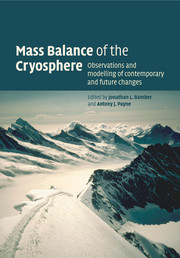Book contents
- Frontmatter
- Contents
- List of contributors
- Foreword
- Preface
- 1 Introduction and background
- Part I Observational techniques and methods
- Part II Modelling techniques and methods
- Part III The mass balance of sea ice
- Part IV The mass balance of the ice sheets
- Part V The mass balance of ice caps and glaciers
- Index
- References
1 - Introduction and background
Published online by Cambridge University Press: 16 October 2009
- Frontmatter
- Contents
- List of contributors
- Foreword
- Preface
- 1 Introduction and background
- Part I Observational techniques and methods
- Part II Modelling techniques and methods
- Part III The mass balance of sea ice
- Part IV The mass balance of the ice sheets
- Part V The mass balance of ice caps and glaciers
- Index
- References
Summary
Aims and objectives of the book
The cryosphere can loosely be defined as all frozen water and soil on the surface of the Earth. This definition encompasses a diverse range of ice masses with a vast spectrum of spatial and temporal characteristics. It ranges from ephemeral river and lake ice to the quasi-permanent (on a millennial timescale) ice sheets of Antarctica and Greenland. Included in the definition is seasonal snow cover and permafrost. In compiling this book it was neither possible nor desirable to include all these different components. This is because the processes and interactions at play are as diverse as the components and, in some cases, unrelated. We have focussed here on two key components, which interact with each other and with the rest of the climate system in an inter-related way. They are land ice, in the form of ice sheets, caps and glaciers, and sea ice. Combined, these represent, at any one time, by far the largest component of ice on the planet, both by volume and area, yet respond to climate change over timescales ranging from seasons to millennia. Sea ice has been identified by the Intergovernmental Panel for Climate Change (IPCC) as a key indicator of short-term climate change, while land-based ice masses may have contributed as much as 50% of attributable sea-level rise during the twentieth century, and represent a large uncertainty in our predictions of a future rise (Houghton et al., 2001).
- Type
- Chapter
- Information
- Mass Balance of the CryosphereObservations and Modelling of Contemporary and Future Changes, pp. 1 - 8Publisher: Cambridge University PressPrint publication year: 2004



